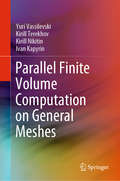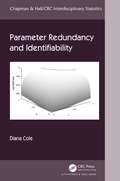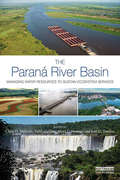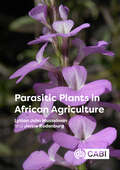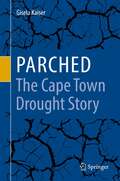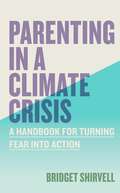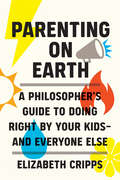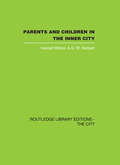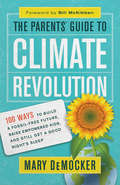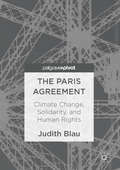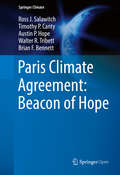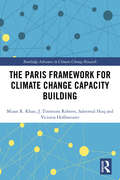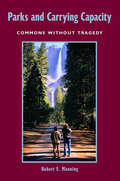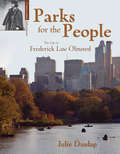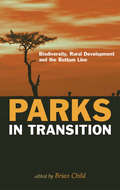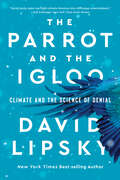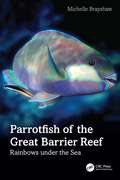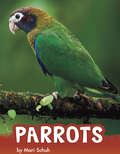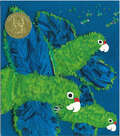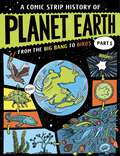- Table View
- List View
Parallel Finite Volume Computation on General Meshes
by Yuri Vassilevski Kirill Terekhov Kirill Nikitin Ivan KapyrinThis book presents a systematic methodology for the development of parallel multi-physics models and its implementation in geophysical and biomedical applications. The methodology includes conservative discretization methods for partial differential equations on general meshes, as well as data structures and algorithms for organizing parallel simulations on general meshes. The structures and algorithms form the core of the INMOST (Integrated Numerical Modelling Object-oriented Supercomputing Technologies) platform for the development of parallel models on general meshes. The authors consider applications for addressing specific geophysical and biomedical challenges, including radioactive contaminant propagation with subsurface waters, reservoir simulation, and clot formation in blood flows. The book gathers all the components of this methodology, from algorithms and numerical methods to the open-source software, as well as examples of practical applications, in a single source, making it a valuable asset for applied mathematicians, computer scientists, and engineers alike.
Parameter Redundancy and Identifiability (Chapman & Hall/CRC Interdisciplinary Statistics)
by Diana ColeStatistical and mathematical models are defined by parameters that describe different characteristics of those models. Ideally it would be possible to find parameter estimates for every parameter in that model, but, in some cases, this is not possible. For example, two parameters that only ever appear in the model as a product could not be estimated individually; only the product can be estimated. Such a model is said to be parameter redundant, or the parameters are described as non-identifiable. This book explains why parameter redundancy and non-identifiability is a problem and the different methods that can be used for detection, including in a Bayesian context. Key features of this book: Detailed discussion of the problems caused by parameter redundancy and non-identifiability Explanation of the different general methods for detecting parameter redundancy and non-identifiability, including symbolic algebra and numerical methods Chapter on Bayesian identifiability Throughout illustrative examples are used to clearly demonstrate each problem and method. Maple and R code are available for these examples More in-depth focus on the areas of discrete and continuous state-space models and ecological statistics, including methods that have been specifically developed for each of these areas This book is designed to make parameter redundancy and non-identifiability accessible and understandable to a wide audience from masters and PhD students to researchers, from mathematicians and statisticians to practitioners using mathematical or statistical models.
Parameterization Schemes
by David J. StensrudNumerical weather prediction models play an increasingly important role in meteorology, both in short- and medium-range forecasting and global climate change studies. The most important components of any numerical weather prediction model are the subgrid-scale parameterization schemes, and the analysis and understanding of these schemes is a key aspect of numerical weather prediction. This book provides in-depth explorations of the most commonly used types of parameterization schemes that influence both short-range weather forecasts and global climate models. Several parameterizations are summarised and compared, followed by a discussion of their limitations. Review questions at the end of each chapter enable readers to monitor their understanding of the topics covered, and solutions are available to instructors at www. cambridge. org/9780521865401. This will be an essential reference for academic researchers, meteorologists, weather forecasters, and graduate students interested in numerical weather prediction and its use in weather forecasting.
The Paraná River Basin: Managing Water Resources to Sustain Ecosystem Services (Earthscan Series on Major River Basins of the World)
by Chris D. MetcalfeThis book provides insight into the hydrology, ecosystem services and management of water resources in the Paraná River basin, including the importance of water to the socio-economic development of the countries within the watershed. Running through Brazil. Paraguay and Argentina, the Paraná River and its watershed is home to some of South America's major population centers as well as important ecosystems threatened by development. At the same time, the river is a major resource driving the economies of the nations within its boundaries. This volume examines the impacts of environmental degradation, and the tradeoffs between the energy sector and the maintenance of ecosystem services. In particular, it focuses on the threats from development to sensitive ecosystems within the basin and the challenges of transboundary management of water resources. In addition to presenting wider perspectives on water management, the volume specifically covers water infrastructure, aquatic ecosystems, water quality, geomorphological influences and the impact of climate change. Finally, by assessing each country's current status in meeting the Sustainable Development Goals this volume provides a timely analysis as national governments within the basin are becoming increasingly concerned about the sustainability of the freshwater ecosystems within the Paraná River basin. This book will be of great interest to students and scholars of water and natural resource management, environmental policy, sustainable development and Latin American studies. It will also be relevant to water management professionals.
Parasitic Plants in African Agriculture
by Professor Lytton John Musselman Dr Jonne RodenburgParasitic Plants in African Agriculture brings together for the first time in a single volume, the ecology, biology, damage, and control of all groups of African parasitic plants including both the relatively few parasites introduced to the continent as well as those native parasites that have spread from within Africa. The book covers the well-known witchweeds and broomrapes but also groups and species that have received less attention including mistletoes, dodders, rice vampire weed, and other species posing threats. The book distinguishes between stem and root parasitic weeds and between holoparasites and (facultative or obligate) hemiparasites. Based on their research and experience collectively spanning six decades, the authors provide an authoritative and state-of-the-art overview of the distribution, biology and impact of these highly specialized weeds and include recommendations for their management. Since parasitic plants in African agriculture primarily affect smallholder farmers, these weeds are explicitly discussed within a context of resource limitations and global changes. Readers are informed on all parasitic plant species relevant to African agriculture and the impact these plants have on crop production and livelihoods of smallholders in a changing world. Current and future management strategies are outlined in terms of their principles and effectiveness as well as their feasibility and affordability for farmers, all of which determine farmer adoption. The final chapter synthesises some of the relevant findings and statistics regarding parasitic weed distribution and their host crops and discusses implications in terms of future crop protection concerns in African agricultural systems. Key features: · Authoritative text based on extensive field and laboratory work. · First comprehensive state-of-the-art overview of parasitic plants and their management in Africa. · Highly illustrated with photos, graphs and species distribution maps. · Reviews previous basic and applied work, with relevance to smallholder farming systems. This book will be a valuable reference for students, researchers, extension workers, development officers, national agriculture researchers, plant pathologists, food security specialists, weed scientists, agronomists and botanists.
Parched - The Cape Town Drought Story
by Gisela KaiserThe book presents the history of water supply to Cape Town, leading up to the worst ever drought recorded, through political turmoil impacting on drought interventions and resulting in the adoption of an integrated water strategy.Regions reliant on water supply from rainfed dams have always been vulnerable to the impact of drought. This is exacerbated by the uncertainty of future rainfall, which is never guaranteed, and reliance is placed on modelling using historic data. While weather has always been variable, climate has been generally reliable. With anthropogenic activity causing changes in climate, the validity of modelling based on history is currently not fully trusted. Unless the storage capacity is sufficient to carry through numerous seasons of poor rainfall, even with water restrictions to match demand and supply in times of depleted rainfall, the risk of reservoirs running dry remains a threat.
Parenting in a Climate Crisis: A Handbook for Turning Fear into Action
by Bridget ShirvellIn this urgent parenting guide, learn how to navigate the uncertainty of the climate crisis and keep your kids informed, accountable, and hopeful–with simple actions you can take as a family to help the earth. Kids today are experiencing the climate crisis firsthand. Camp canceled because of wildfire smoke. Favorite beaches closed due to erosion. Recess held indoors due to extreme heat. How do parents help their children make sense of it all? And how can we keep our kids (and ourselves) from despair? Environmental journalist and parent Bridget Shirvell has created a handbook for parents to help them navigate these questions and more, weaving together expert advice from climate scientists, environmental activists, child psychologists, and parents across the country. She helps parents answer tough questions (how did we get here?) and raise kids who feel connected to and responsible for the natural world, feel motivated to make ecologically sound choices, and feel empowered to meet the challenges of the climate crisis—and to ultimately fight for change.
Parenting on Earth: A Philosopher's Guide to Doing Right by Your Kids and Everyone Else
by Elizabeth CrippsBeing parents and being human: building hope for our children in a fragile world.Environmental catastrophes, pandemics, antibiotic resistance, institutionalized injustice, and war: in a world so out of balance, what does it take—or even mean—to be a good parent? This book is one woman&’s search for an answer, as a moral philosopher, activist, and mother.Drawing on the insights of philosophy and the experience of parent activists, Elizabeth Cripps calls for parents to think radically about exactly what we owe our children—and everyone else. She shows how our children&’s needs are inseparable from the fate of the earth and the fortunes of others and how much is at stake in parenting today. And she asks the hardest question: should we have kids at all?Timely and thoughtful, Parenting on Earth extends a challenge to anyone raising children in a troubled world—and with it, a vision of hope for our children&’s future. Cripps envisions a world where kids can prosper and grow—a just world, with thriving social systems and ecosystems, where future generations can flourish and all children can lead a decent life. She explains, with bracing clarity, why those raising kids today should be a force for change and bring up their children to do the same. Hard as this can be, in the face of political gridlock, ecoanxiety, and general daily grind, the tools of philosophy and psychology can help us find a way.
Parents and Children in the Inner City
by Harriett Wilson G.W. HerbertThis book was first published in 1978.
The Parents’ Guide to Climate Revolution: 100 Ways to Build a Fossil-Free Future, Raise Empowered Kids, and Still Get a Good Night’s Sleep
by Bill McKibben Mary DeMocker“Relax,” writes author Mary DeMocker, “this isn’t another light bulb list. It’s not another overwhelming pile of parental ‘to dos’ designed to shrink your family’s carbon footprint through eco-superheroism.” Instead, DeMocker lays out a lively, empowering, and doable blueprint for engaging families in the urgent endeavor of climate revolution. In this book’s brief, action-packed chapters, you’ll learn hundreds of wide-ranging ideas for being part of the revolution — from embracing simplicity parenting, to freeing yourself from dead-end science debates, to teaching kids about the power of creative protest, to changing your lifestyle in ways that deepen family bonds, improve moods, and reduce your impact on the Earth. Engaging and creative, this vital resource is for everyone who wants to act effectively — and empower children to do the same.
Parícutin: The Life and Death of a Volcano (Fountas & Pinnell LLI Purple #Level R)
by Laura TabbertThe ground swelled and raised itself... Fine dust, like ashes, began to rise from the crack. Smoke began to rise with a loud hiss.
The Paris Agreement
by Judith BlauThis book discusses the immediate and severe threat posed by global climate change and the various obstacles that stand in the way of action. Judith Blau presents scientific evidence relevant to The Paris Agreement (COP-21): an international treaty that promises to strengthen the global response to climate change. As she reckons with the dangers of catastrophic planetary heating, Blau discusses the clash between the deeply ingrained American tradition of individualism and the collective action and acknowledgement of intertwined fate needed to address climate change. She acknowledges that America's capitalist bent stands in contrast to the idea of the "commons"--a concept that we need to embrace if climate change is to be mitigated. The volume also explains the foundations of international human rights standards as they relate to climate change. Drawing from guiding principles of human rights and equality, the book concludes hopefully--suggesting that the people of the world can meet the challenge posed by climate change by at once acknowledging shared humanity and celebrating difference.
Paris Climate Agreement: Beacon of Hope
by Ross J. Salawitch Timothy P. Canty Austin P. Hope Walter R. Tribett Brian F. BennettThis book is open access under a CC BY 4. 0 license. This volume presents an Empirical Model of Global Climate developed by the authors and uses that model to show that global warming will likely remain below 2#65533;C, relative to preindustrial, throughout this century provided: a) both the unconditional and conditional Paris INDC commitments are followed; b) the emission reductions needed to achieve the Paris INDCs are carried forward to 2060 and beyond. The first section of the book provides a short overview of Earth's climate system, describing and contrasting climatic changes throughout the planet's history and anthropogenic changes post-Industrial Revolution. The second section describes the climate model developed by the authors (Canty et al. , Atmospheric Chemistry and Physics, 2013) and contrasts the model with climate models used in the Intergovernmental Panel on Climate Change (IPCC) 2013 Report. Chapter 3 examines both the unconditional (i. e. , firm commitments) and conditional Paris INDCs (commitments contingent on financial flow and/or technology transfer) through the lens of their climate model and concludes that if all of the Paris INDCs are followed, then they are indeed a beacon of hope for Earth's climate. The fourth part of the book offers a perspective of energy needs and subsequent emissions reductions required to meet the Paris temperature goals, illuminating challenges faced both in the developing world and the developed world. Throughout the book, easy-to-understand charts and graphics illustrate concepts. The scientific basis of Chapters 2 and 3 was first presented in a keynote session of the 96th Annual Meeting of the American Meteorological Society in January, 2016.
The Paris Framework for Climate Change Capacity Building (Routledge Advances in Climate Change Research)
by Mizan R Khan J. Timmons Roberts Saleemul Huq Victoria HoffmeisterThe Paris Framework for Climate Change Capacity Building pioneers a new era of climate change governance, performing the foundational job of clarifying what is meant by the often ad-hoc, one-off, uncoordinated, ineffective and unsustainable practices of the past decade described as 'capacity building' to address climate change. As an alternative, this book presents a framework on how to build effective and sustainable capacity systems to meaningfully tackle this long-term problem. Such a reframing of capacity building itself requires means of implementation. The authors combine their decades-long experiences in climate negotiations, developing climate solutions, climate activism and peer-reviewed research to chart a realistic roadmap for the implementation of this alternative framework for capacity building. As a result, this book convincingly makes the case that universities, as the highest and sustainable seats of learning and research in the developing countries, should be the central hub of capacity building there. This will be a valuable resource for students, researchers and policy-makers in the areas of climate change and environmental studies.
Parisar Adyayan Bhag-1 class 4 - Maharashtra Board: परिसर अध्ययन भाग-१ ४थीं कक्षा - महाराष्ट्र बोर्ड
by Maharashtra Rajya Pathyapustak Nirmiti Va Abhysakram Sanshodhan Mandal Pune"परिसर अध्ययन (भाग 1)" महाराष्ट्र राज्य पाठ्यपुस्तक मंडल द्वारा प्रकाशित चौथी कक्षा के लिए एक महत्वपूर्ण पाठ्यपुस्तक है। यह पुस्तक विद्यार्थियों को उनके प्राकृतिक, सामाजिक, और सांस्कृतिक परिवेश को समझने में मदद करती है। इसमें प्राणियों, पौधों, जल, हवा, मानचित्र, परिवहन, संचार, प्राकृतिक आपदाएँ और सामूहिक जीवन जैसे विषयों को सरल और रोचक भाषा में प्रस्तुत किया गया है। पुस्तक का उद्देश्य बच्चों में पर्यावरणीय जागरूकता बढ़ाना, सामूहिक उत्तरदायित्व सिखाना और जीवन कौशल विकसित करना है। इसके अध्याय गतिविधियों, स्वाध्याय और रोचक चित्रों से भरे हैं, जो बच्चों की कल्पनाशक्ति और रचनात्मकता को प्रेरित करते हैं। यह पुस्तक बच्चों को पर्यावरण का सम्मान करना, संसाधनों का उपयोग सही तरीके से करना, और वैज्ञानिक दृष्टिकोण अपनाने के लिए प्रेरित करती है। यह बच्चों के व्यवहार, ज्ञान और सोचने की क्षमता को सुधारने में मददगार है।
Parisar Adyayan Bhag-1 class 5 - Maharashtra Board: परिसर अध्ययन भाग-१ ५वीं कक्षा - महाराष्ट्र बोर्ड
by Maharashtra Rajya Pathyapustak Nirmiti Va Abhysakram Sanshodhan Mandal Pune"परिसर अध्ययन भाग 1" महाराष्ट्र बोर्ड की कक्षा 5 की हिंदी पाठ्यपुस्तक है, जो प्राकृतिक, सामाजिक और सांस्कृतिक परिवेश की जानकारी प्रदान करती है। इसमें छात्रों को पृथ्वी, पर्यावरण, मानचित्र, नागरिक शास्त्र, परिवार, सार्वजनिक सुविधाएँ, जल स्रोत, खाद्य सुरक्षा, संचार, परिवहन, स्वास्थ्य और समुदाय से जुड़ी मूलभूत अवधारणाएँ सिखाई जाती हैं। पुस्तक में वैज्ञानिक दृष्टिकोण विकसित करने पर बल दिया गया है और छात्र गतिविधियों के माध्यम से व्यावहारिक ज्ञान प्राप्त कर सकते हैं। इसमें चित्र, मानचित्र, प्रश्नोत्तर, और व्यावहारिक गतिविधियाँ शामिल हैं, जो छात्रों को अपने आसपास के वातावरण को समझने और उसमें सुधार करने के लिए प्रेरित करती हैं। इस पाठ्यपुस्तक का उद्देश्य बच्चों को आत्मनिर्भर और जागरूक नागरिक बनाना है, जो समाज और पर्यावरण के प्रति उत्तरदायी हों।
Parks and Carrying Capacity: Commons Without Tragedy
by Robert E. ManningHow much can we use the environment without spoiling what we find so valuable about it? Determining the carrying capacity of parks and related areas is a perennial question whose urgency grows each year as the number of visits continues to increase. Parks and Carrying Capacity represents a comprehensive assessment of the issue, as it:* offers a historical and conceptual treatment ofcarrying capacity* describes and illustrates research approaches forassessing carrying capacity, including qualitative and quantitativesurveys, normative theory and methods, visual research approaches,trade-off analysis, and simulation modeling* examines management alternatives for limiting the environmentaland social impacts of visitor use* considers the broader question of environmental management andhow the issue of carrying capacity can be applied more generally* discusses how the theory and methods associated with managingthe carrying capacity of parks and protected areas might be extendedto other areas of environmental managementThe book includes a series of case studies that describe research programsdesigned to support analysis and management of carrying capacity at eight diverse units of the U.S. National Park System, and an additional case study that explores how the foundational components of carrying capacity (formulating indicators and standards, monitoring, and adaptive management) are being applied in an increasing number of environmental and natural resources fields to address the growing urgency of sustainability. Parks and Carrying Capacity is an important new work for faculty, graduate and undergraduate students, and researchers in outdoor recreation, park planning and management, and natural resource conservation and management, as well as for professional planners and managers involved with park and outdoor recreation related agencies and nongovernmental organizations.
Parks and Recreation System Planning: A New Approach for Creating Sustainable, Resilient Communities
by David BarthParks and recreation systems have evolved in remarkable ways over the past two decades. No longer just playgrounds and ballfields, parks and open spaces have become recognized as essential green infrastructure with the potential to contribute to community resiliency and sustainability. To capitalize on this potential, the parks and recreation system planning process must evolve as well. In Parks and Recreation System Planning, David Barth provides a new, step-by-step approach to creating parks systems that generate greater economic, social, and environmental benefits.Barth first advocates that parks and recreation systems should no longer be regarded as isolated facilities, but as elements of an integrated public realm. Each space should be designed to generate multiple community benefits. Next, he presents a new approach for parks and recreation planning that is integrated into community-wide issues. Chapters outline each step—evaluating existing systems, implementing a carefully crafted plan, and more—necessary for creating a successful, adaptable system. Throughout the book, he describes initiatives that are creating more resilient, sustainable, and engaging parks and recreation facilities, drawing from his experience consulting in more than 100 communities across the U.S.Parks and Recreation System Planning meets the critical need to provide an up-to-date, comprehensive approach for planning parks and recreation systems across the country. This is essential reading for every parks and recreation professional, design professional, and public official who wants their community to thrive.
Parks for the People
by Julie DunlapWhen Frederick Law Olmsted entered a contest to design the nation's first city park, his winning design became New York's Central Park and forever changed our nation's cities. Using historic photographs and a school resource section, award-winning children's author Julie Dunlap brings Olmsted to life in this biography of the United States' first landscape architect.Julie Dunlap is a freelance writer and researcher. Dunlap's books have been honored with a Teachers' Choice Award from Learning magazine, a Parents' Choice recommended selection, and a Junior Library Guild selection, among others.
Parks in Transition: "Biodiversity, Rural Development and the Bottom Line"
by Brian ChildParks face intense pressure from both environmental and developmental perspectives to conserve biodiversity and provide economic opportunities for rural communities. These imperatives are often in conflict, while potential solutions may be subject to theoretical and practical disagreement and complicated by pressing economic, political and cultural considerations. Parks in Transition collects the work of the most distinguished scholars and practitioners in this field, drawing on insight from over 50 case studies and synthesizing them into lessons to guide park management in transitional economies where the challenges of poverty and governance can be severe. The central message of the book is that parks are common property regimes that are supposed to serve society. It analyses and sheds light on the crucial questions arising from this perspective. If parks are set aside to serve poor people, should conservation demands over-rule demands for jobs and economic growth? Or will deliberately using parks as bridgeheads for better land use and engines for rural development produce more and better conservation? The issue that arises at all levels is that of accountability, including the problematic linkages between park authorities and political systems, and the question of how to measure park performance. This book provides vital new insights for park management, regarding the relationship between conservation and commercialization, performance management, new systems of governance and management, and linkages between parks, landscape and the land-use economy.
The Parrot and the Igloo: Climate And The Science Of Denial
by David LipskyA New York Times Editors’ Choice Named a Best Book of the Year in The New Yorker, Publishers Weekly, Chicago Tribune, and EcoLit Books A USA Today Must-Read Summer Book "David Lipsky spins top-flight climate literature into cliffhanger entertainment." —Zoë Schlanger, New York Times Book Review The New York Times best-selling author explores how “anti-science” became so virulent in American life—through a history of climate denial and its consequences. In 1956, the New York Times prophesied that once global warming really kicked in, we could see parrots in the Antarctic. In 2010, when science deniers had control of the climate story, Senator James Inhofe and his family built an igloo on the Washington Mall and plunked a sign on top: AL GORE'S NEW HOME: HONK IF YOU LOVE CLIMATE CHANGE. In The Parrot and the Igloo, best-selling author David Lipsky tells the astonishing story of how we moved from one extreme (the correct one) to the other. With narrative sweep and a superb eye for character, Lipsky unfolds the dramatic narrative of the long, strange march of climate science. The story begins with a tale of three inventors—Thomas Edison, George Westinghouse, and Nikola Tesla—who made our technological world, not knowing what they had set into motion. Then there are the scientists who sounded the alarm once they identified carbon dioxide as the culprit of our warming planet. And we meet the hucksters, zealots, and crackpots who lied about that science and misled the public in ever more outrageous ways. Lipsky masterfully traces the evolution of climate denial, exposing how it grew out of early efforts to build a network of untruth about products like aspirin and cigarettes. Featuring an indelible cast of heroes and villains, mavericks and swindlers, The Parrot and the Igloo delivers a real-life tragicomedy—one that captures the extraordinary dance of science, money, and the American character.
Parrotfish of the Great Barrier Reef: Rainbows under the Sea
by Michelle BrayshawThe array of colours found on the Scarini tribe (family: Labridae), commonly known as the Parrotfish, is truly astounding and is showcased to breathtaking effect in this book. Photographer and artist Michelle Brayshaw reveals the array of colour changes which these fish display through ontological (slow) and physiological (fast) processes. The obvious differences occur in the three phases of their lives, but it is the subtle changes in colour that can be the most bizarre, occurring while feeding, mating, courting, cleaning, camouflaging themselves to their backgrounds or the fish around them, experiencing mood swings, fighting, playing and, most excitingly of all, when they are transitioning from female to male. This feat is not unique to the Parrotfish, but no other animals do it with such glamour and colour.Through hundreds of hours of observational research, this book highlights the light play and physiological and ontological colour changes of the Scarini found on the Great Barrier Reef in stunning photographic accuracy. It also includes comprehensive information about why Parrotfish are so important for the health and resilience of the reef,f instilling in the reader a deeper sense of the treasures found there and reminding us of the interconnected nature of our existence.
Parrots (Animals)
by Mari SchuhParrots can do more than just mimic human speech. These colorful, sassy birds often mate for life, and some parrots can live 90 years or more. Learn more about these intelligent birds. <P><P><i>Advisory: Bookshare has learned that this book offers only partial accessibility. We have kept it in the collection because it is useful for some of our members. Benetech is actively working on projects to improve accessibility issues such as these.</i>
Parrots Over Puerto Rico
by Susan L. Roth Cindy TrumboreRobert F. Sibert Informational Book Award - American Library Association (ALA)A nonfiction picture book about the history of Puerto Rico and the Puerto Rican parrot, which was brought back from the brink of extinction. Also available in Spanish.Above the treetops of Puerto Rico flies a flock of parrots as green as their island home... These are Puerto Rican parrots. They lived on this island for millions of years, and then they nearly vanished from the earth forever.Puerto Rican parrots, once abundant, came perilously close to extinction in the 1960s due to centuries of foreign exploration and occupation, development, and habitat destruction. In this compelling book, Roth and Trumbore recount the efforts of the scientists of the Puerto Rican Parrot Recovery Program to save the parrots and ensure their future. Woven into the parrots' story is a brief history of Puerto Rico itself, from before the first human settlers to the present day.With striking collage illustrations, a unique format, and engaging storytelling, Parrots Over Puerto Rico invites readers to witness the amazing recovery efforts that have enabled Puerto Rican parrots to fly over their island once again.
Part 1 From the Big Bang to Birds (A Comic Strip History of Planet Earth #1)
by Anna ClaybourneA funny, fresh comic-strip look at the amazing (and very long!) history of planet EarthTake a whirlwind comic strip trip through 4.5 billion fascinating years of Earth's history, discovering how Earth and the solar system formed, how the first life evolved in the oceans, LUCA, the ancestor of all living things, what became of the dinosaurs, and much, MUCH more.Each book works as a timeline, combining information spreads with comic strip stories, and supported throughout by high-interest facts and plenty of humour. Perfect for kids aged 9 and up.Contents: Our humble home/The whole of time at a glance!/It started with a BANG!/Nothing! Or was there?/Hello sunshine!/The early Earth/Collision course/Water world/It's raining rocks!/A spark of life/Meet your ancestor! Millions of years of microbes/New cells on the block/Land on the move/Party atmosphere!/Snowball Earth/Animals arrive/Life explosion/Stepping ashore/Green scene/The age of fish/Tetrapod takeover/Day of the dinosaurs/Phew! What a scorcher!/Dinosaur battle/Sea and sky monsters/Furry and feathery/Asteroid alert!/Goodbye dinosaurs/Glossary/Index
